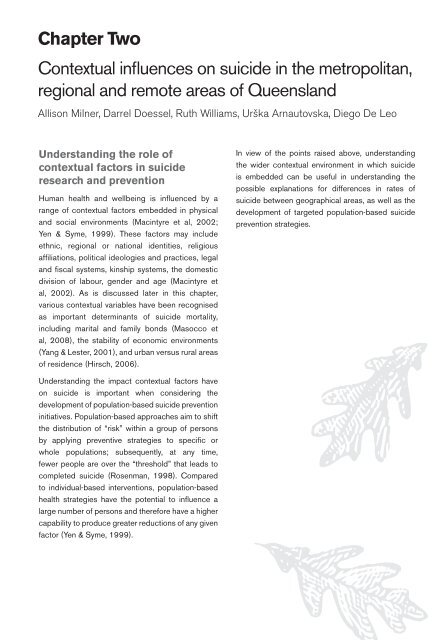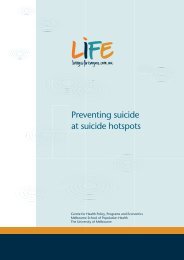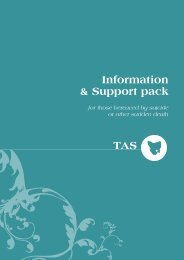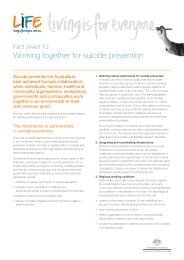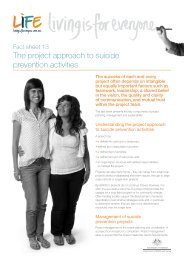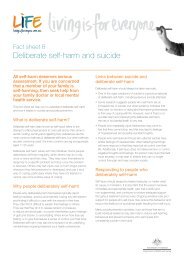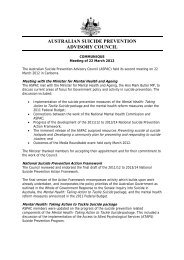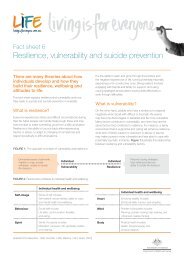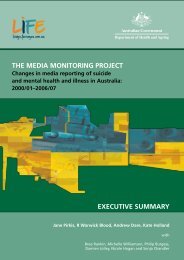SUICIDE in RURAL & REMOTE AREAS of AUSTRALIA - Living is for ...
SUICIDE in RURAL & REMOTE AREAS of AUSTRALIA - Living is for ...
SUICIDE in RURAL & REMOTE AREAS of AUSTRALIA - Living is for ...
You also want an ePaper? Increase the reach of your titles
YUMPU automatically turns print PDFs into web optimized ePapers that Google loves.
Chapter Two<br />
Contextual <strong>in</strong>fluences on suicide <strong>in</strong> the metropolitan,<br />
regional and remote areas <strong>of</strong> Queensland<br />
All<strong>is</strong>on Milner, Darrel Doessel, Ruth Williams, Urška Arnautovska, Diego De Leo<br />
Understand<strong>in</strong>g the role <strong>of</strong><br />
contextual factors <strong>in</strong> suicide<br />
research and prevention<br />
Human health and wellbe<strong>in</strong>g <strong>is</strong> <strong>in</strong>fl uenced by a<br />
range <strong>of</strong> contextual factors embedded <strong>in</strong> physical<br />
and social environments (Mac<strong>in</strong>tyre et al, 2002;<br />
Yen & Syme, 1999). These factors may <strong>in</strong>clude<br />
ethnic, regional or national identities, religious<br />
affi liations, political ideologies and practices, legal<br />
and fi scal systems, k<strong>in</strong>ship systems, the domestic<br />
div<strong>is</strong>ion <strong>of</strong> labour, gender and age (Mac<strong>in</strong>tyre et<br />
al, 2002). As <strong>is</strong> d<strong>is</strong>cussed later <strong>in</strong> th<strong>is</strong> chapter,<br />
various contextual variables have been recogn<strong>is</strong>ed<br />
as important determ<strong>in</strong>ants <strong>of</strong> suicide mortality,<br />
<strong>in</strong>clud<strong>in</strong>g marital and family bonds (Masocco et<br />
al, 2008), the stability <strong>of</strong> economic environments<br />
(Yang & Lester, 2001), and urban versus rural areas<br />
<strong>of</strong> residence (Hirsch, 2006).<br />
In view <strong>of</strong> the po<strong>in</strong>ts ra<strong>is</strong>ed above, understand<strong>in</strong>g<br />
the wider contextual environment <strong>in</strong> which suicide<br />
<strong>is</strong> embedded can be useful <strong>in</strong> understand<strong>in</strong>g the<br />
possible explanations <strong>for</strong> differences <strong>in</strong> rates <strong>of</strong><br />
suicide between geographical areas, as well as the<br />
development <strong>of</strong> targeted population-based suicide<br />
prevention strategies.<br />
Understand<strong>in</strong>g the impact contextual factors have<br />
on suicide <strong>is</strong> important when consider<strong>in</strong>g the<br />
development <strong>of</strong> population-based suicide prevention<br />
<strong>in</strong>itiatives. Population-based approaches aim to shift<br />
the d<strong>is</strong>tribution <strong>of</strong> “r<strong>is</strong>k” with<strong>in</strong> a group <strong>of</strong> persons<br />
by apply<strong>in</strong>g preventive strategies to specifi c or<br />
whole populations; subsequently, at any time,<br />
fewer people are over the “threshold” that leads to<br />
completed suicide (Rosenman, 1998). Compared<br />
to <strong>in</strong>dividual-based <strong>in</strong>terventions, population-based<br />
health strategies have the potential to <strong>in</strong>fl uence a<br />
large number <strong>of</strong> persons and there<strong>for</strong>e have a higher<br />
capability to produce greater reductions <strong>of</strong> any given<br />
factor (Yen & Syme, 1999).<br />
GriffithBook FINAL 20/09.<strong>in</strong>dd 19<br />
15/11/12 4:28 PM


